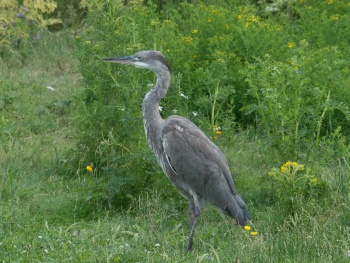Nutcracker (talk | contribs) (format) |
Nutcracker (talk | contribs) m (format) |
||
| Line 2: | Line 2: | ||
;[[:Category:Ardea|Ardea]] cinerea | ;[[:Category:Ardea|Ardea]] cinerea | ||
==Identification== | ==Identification== | ||
| − | [[Image:grey_heron_alok.JPG|thumb|350px|right| | + | [[Image:grey_heron_alok.JPG|thumb|350px|right|''A. c. cinerea'', courting pair that mated a few minutes later<br />Photo by {{user|aloktewari|Alok Tewari}}<br/>[[Keoladeo National Park]], Bharatpur, Rajasthan, [[India]], December-2013]] |
Length 90–98 cm (35½-38½ in), wingspan 175–195 cm, weight 1–2 kg | Length 90–98 cm (35½-38½ in), wingspan 175–195 cm, weight 1–2 kg | ||
*Bright white crown | *Bright white crown | ||
Revision as of 12:08, 13 December 2017
- Ardea cinerea
Identification

Photo by Alok Tewari
Keoladeo National Park, Bharatpur, Rajasthan, India, December-2013
Length 90–98 cm (35½-38½ in), wingspan 175–195 cm, weight 1–2 kg
- Bright white crown
- Black line running from above and behind the eye to the nape and extending as a pair of short plumes
- White neck with a double row of black streaks down the throat
- Underparts pale grey
- Black patch from shoulder down to flanks
- Grey back and wings
- Long, yellow bill (becomes orange-pink in courtship)
- Greenish-yellow legs and feet
- All-grey underwing
- Juvenile duller and drabber, with dark grey crown, grey neck and greyish-yellow bill
- Second year intermediate between juvenile and adult
Distribution
A very widespread Old World species breeding across much of Eurasia and Africa. Breeds throughout the British Isles and much of mainland Europe from north and central France north to coastal Scandinavia and east across Russia to Sakhalin, Manchuria and Japan. In the south found at scattered localities from Iberia to Greece and Turkey, the Caucasus and east across southern Asia, India and Indochina south to Sumatra and Java. In Africa breeds on the Mediterranean coast and in the Nile Valley, on the Banc D'Arguin in Mauritania, probably also on the Azores, in West Africa, western Madagascar and from Ethiopia south to South Africa.
Northernmost birds are migratory and winter range is more extensive in Europe, Africa, south-west Asia and Indonesia. Vagrant north to Greenland and Svalbard and to the south a rare resident/migrant or vagrant to Azores and Cape Verde Islands. Also recorded on Bermuda, the West Indies and in Newfoundland.
Taxonomy
Subspecies
There are 4 subspecies[1]:
- A. c. cinerea occurs over most of range except as below
- A. c. monicae on the Banc D'Arguin of Mauritania
- A. c. jouyi in the east from Japan to Java
- A. c. firasa on Madagascar, Aldabra and the Comoros
The subspecies differ slightly in size and grey tone; A. c. monicae is the palest subspecies.
Habitat
Colonial breeder, usually in trees, sometimes on a cliff or in reedbeds; A. c. monicae nests on the ground on islets. Frequents the margins of a variety of freshwater including lakes, streams and swamps, brackish lagoons and estuaries, and often sea coasts. Also feeds or rests on grassland.
In some parts of range a common bird in urban areas. The Grey Heron is a familiar bird of lakes, rivers, pans and also rocky coastlines where it is usually seen hunting in shallow water.
Behaviour
Birds spend long periods standing still in the water, waiting patiently for prey to swim within range of a lightning fast lunge of the bill.
They have occasionally been observed to swim.[6]
Flight
Like others of the family, the Grey Heron flies with its long neck retracted and the head pulled back into its shoulders.
Diet
Opportunist feeders, Grey Herons eat a wide variety of fish, invertebrates, ducklings and land animals, such as rats and young rabbits.
They have even been recorded catching swifts, by ambushing them under a low level bridge.[2]
Breeding
Colonial breeders, often mixed with other species such as egrets, cormorants and spoonbills. The colony is almost always associated with water - fresh or salt.
The nest is an untidy platform of sticks, usually at the top of a tall tree. Usual clutch size is 3-4 eggs.
Vocalisation
The call is a harsh kraaank.
<flashmp3>Ardea cinerea (song).mp3</flashmp3>
Listen in an external program
An adult flying overhead and giving continuous calls, in the recording, done in winter, below :
<flashmp3>grey_heron_call_alok.mp3</flashmp3>
Listen in an external program
Recording by Alok Tewari
Nazafgarh Wetlands and Marshes, Gurgaon, Haryana, India, January-2017
In Culture
Other Names
German: Graureiher; Afrikaans: Bloureier; Polish: Czapla siwa; Gaelic: Corra-Ghritheach
References
- Clements, J. F., T. S. Schulenberg, M. J. Iliff, D. Roberson, T. A. Fredericks, B. L. Sullivan, and C. L. Wood. 2017. The eBird/Clements checklist of birds of the world: v2017, with updates to August 2017. Downloaded from http://www.birds.cornell.edu/clementschecklist/download/
- In Nature
- Collins Pocket Guide to British Birds 1966
- Collins Field Guide 5th Edition
- Collins Bird Guide ISBN 0 00 219728 6
- Swimming Grey Heron, Birdforum discussion thread
Recommended Citation
- BirdForum Opus contributors. (2024) Grey Heron. In: BirdForum, the forum for wild birds and birding. Retrieved 24 April 2024 from https://www.birdforum.net/opus/Grey_Heron
External Links







